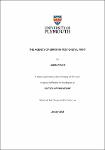The Agency of Error in Post-digital Print
| dc.contributor.supervisor | Prior, Andrew | |
| dc.contributor.author | Rosser, Laura | |
| dc.contributor.other | School of Art, Design and Architecture | en_US |
| dc.date.accessioned | 2023-04-13T14:28:56Z | |
| dc.date.available | 2023-04-13T14:28:56Z | |
| dc.date.issued | 2023 | |
| dc.identifier | 10373232 | en_US |
| dc.identifier.uri | https://pearl.plymouth.ac.uk/handle/10026.1/20672 | |
| dc.description.abstract |
This research investigates the tensions between different interpretations of error: from binary and digital evaluations to the more abstract and human ways we approach and think about error. My interest comes from a meshing together of these tendencies and the slippages between various modes of interpretation. Consequently, in my artistic practice error exists as both activity and subject matter, and the projects expose relationality rather than define discrete types of error. This approach goes against common understandings of error in digital culture, where systems try to reduce, if not erase, error. Equally in relation to printmaking practices, error is often understood only in terms of visual anomalies to be avoided through improvements to the printing process – whereas the problem is that there is a concern with error in print practices and culture, and yet a failure to address it critically. In this respect, error is encapsulated by Gilles Deleuze’s phrase ‘misadventures of thought’ (1994, p.148), which distinguishes error as a form of wandering and implies a state of unknowing. This expanded sense of error has the potential to open up new lines of thinking, in that not knowing upholds new beginnings and artistic potential. My research is not just about error in the ontological sense of the word, but about error in the context of a particular set of creative practices and concepts including printmaking, ideas of the post-digital, and how these allow for an emphasis on what I refer to as the relational agency of error. In his elaboration of the post-digital, the theorist Florian Cramer suggests that artists favour the misbehaviour of failing analogue and digital technologies (2014, p.20). I apply this theory to the expanded field of printmaking where errors created using analogue and digital print equipment co-exist as creative tools in artistic practice. Indeed, how is error in printmaking understood differently as a consequence of post-digital practices, and cultures? Artistic practice in post- digital printmaking takes issue with the crude distinction between digital and analogue creative processes, and instead reveals how new and old technologies intertwine in ’a space of creative action’ (Geary and Catanese, 2012, p.8). This places emphasis on relationality rather than predetermined or unified processes. From a post-digital perspective, and departing from information theory (Shannon and Weaver, 1948), errors and technologies begin to develop their own voices. In my research, I have found that rational thought starts to break down when error occurs – a useful discovery in terms of undermining pre- determined logic and intentionality. Drawing additionally on actor–network theory (Latour), new materialism (Barad and Bennett) and the power of cognitive nonconscious (Hayles), I consider error to be an active agent in the printmaking process, where any notion of the artist’s intention is part of a wider network of relations. Hence, my contribution to knowledge is to propose that error cannot be autonomous and is only active as part of a larger relational web of agency, or a co-constituted agency, distinct from a commonplace understanding where things or matter can exist independently (Harman, 2011a, p. 177). In addition to my artistic practice that forms part of this research and engages with different forms of error, I use diagramming to explore these entangled relations, and to highlight the importance that is ascribed to relationality in understanding error. In this sense, my written thesis and artistic practice can be described as attempts to diagram the concept of error. | en_US |
| dc.language.iso | en | |
| dc.publisher | University of Plymouth | |
| dc.rights | Attribution-NonCommercial-NoDerivs 3.0 United States | * |
| dc.rights.uri | http://creativecommons.org/licenses/by-nc-nd/3.0/us/ | * |
| dc.subject | Post-Digital | en_US |
| dc.subject | en_US | |
| dc.subject | Error | en_US |
| dc.subject | Agency | en_US |
| dc.subject | Printmaking | en_US |
| dc.subject.classification | PhD | en_US |
| dc.title | The Agency of Error in Post-digital Print | en_US |
| dc.type | Thesis | |
| plymouth.version | non-publishable | en_US |
| dc.identifier.doi | http://dx.doi.org/10.24382/5015 | |
| dc.identifier.doi | http://dx.doi.org/10.24382/5015 | |
| dc.rights.embargoperiod | No embargo | en_US |
| dc.type.qualification | Doctorate | en_US |
| rioxxterms.funder | AHRC | en_US |
| rioxxterms.identifier.project | 3D3 | en_US |
| rioxxterms.version | NA |
Files in this item
This item appears in the following Collection(s)
-
01 Research Theses Main Collection
Research Theses Main



